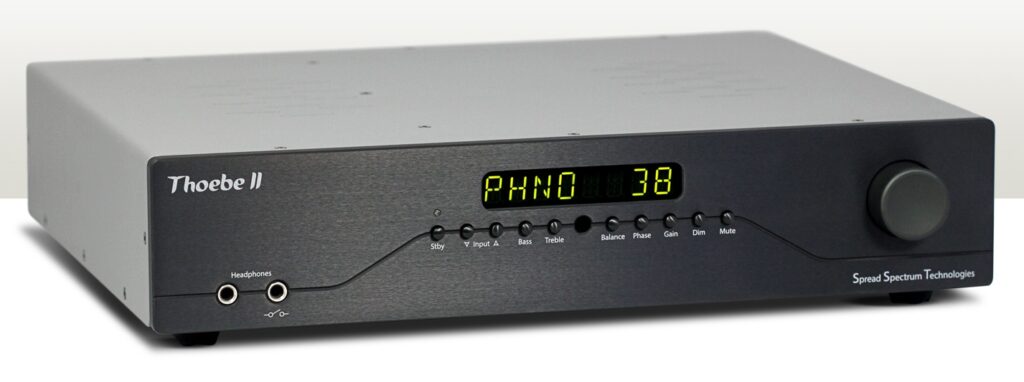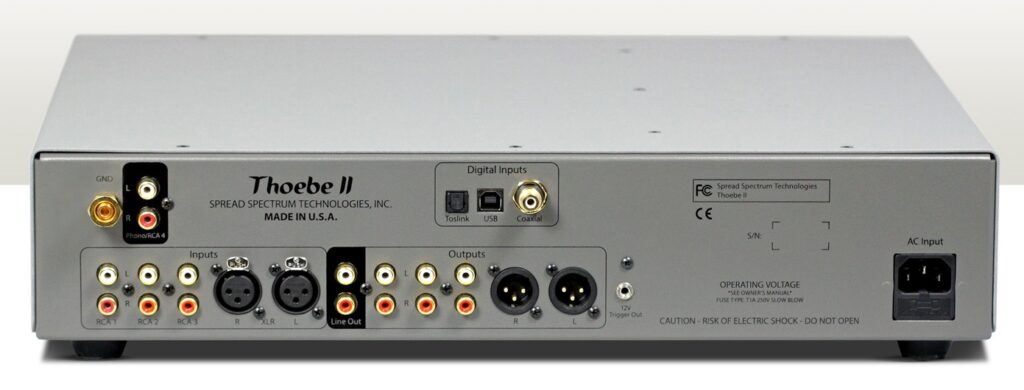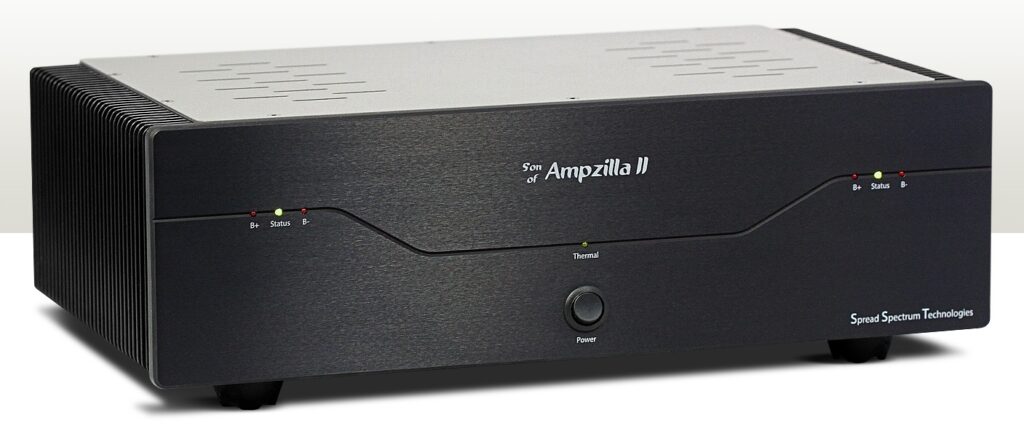
Spread Spectrum Technologies was founded by James Bongiorno, the legendary and colorful audio pioneer and engineer who was also directly involved with key designs at Marantz, SAE, SUMO Electric, and Great American Sounds (GAS). Several years ago, Mr. Bongiorno and Wyred 4 Sound, an OEM manufacturer and producer of its own product line, joined forces to continue the development and production of James’ designs. The genesis of SST is interesting reading and includes some of the key players in contemporary audio history. Please see the SST Web site “About” page for more of the back story.
The Ampzilla Second Edition amplifier was reviewed here and earned the superlative 10 LP rating. Using many of the same circuit features, the new Son of Ampzilla II amplifier, $3,500, is a worthy successor to the classic Son of Ampzilla amplifier which has been in almost continuous, and continuously improving, production for 30+ years. The stereo SOA II is a compact powerhouse rated at 220 Watts per channel and offers both single ended RCA and balanced XLR inputs with a very high signal to noise ratio of 110 dB and very low distortion of 0.03%. These specs tell quite a lot about the sound of SOA II which has very little character of its own.
Other components on hand during the review included a VPI Aries 3D turntable with a VPI 10” tonearm, AMG Teatro and Miyajima Madake moving coil phono cartridges; RCM Sensor 2, Pass XP-25, Musical Surroundings Nova II, and Jasmine LP3.0 phono preamplifiers; Cary DAC-200ts and Auralic Vega DACs both getting their USB signals from a custom Windows 7 music computer running JRiver Media Center 19, a Bent Audio Tap-X autoformer-based preamplifier, Mark Levinson No. 52 preamplifier, Acoustic Imagery Atsah and Pass XA 30.8 power amplifiers; Magnepan 3.7, Emerald Physics 4.7, Scansonic MG 3.5, Focal 714 and PSB Image T speakers. Interconnects included Mogami and Audioquest WEL Signature, with Mogami speaker cables. Power protection and purification are provided by a PS Audio Dectet for the preamplifiers and source components, and a PS Audio Quintet for the power amplifiers. The latter provides remote turn-on and -off of power amplifiers that lack a built-in 12V trigger feature.

The Thoebe II preamplifier, available as a line stage only, carries a base price of $3,500. The optional DAC or MM phono stage each adds $500, or get the fully loaded version with both DAC and phono for $4,250. An all-aluminum remote control adds $175. The Thoebe II offers 3 unbalanced line level inputs on RCAs, 1 balanced line level input on XLRs, 3 unbalanced line level outputs on RCAs, 1 balanced line level output on XLRs, and one pair of unbalanced fixed level outputs. The Class A moving magnet phono stage has 42 dB of gain and has its own pair of RCA inputs. The DAC offers Toslink, USB and coax inputs and can accommodate up to 32 bit 384kHz PCM and DSD64 + DSD128 with the ESS Sabre 9018 32-bit DAC chip.
The preamplifier includes adjustable bass and treble controls, balance and phase controls, a dimmable display and a mute button. The mute is well designed and offers a quick ramp-up and ramp-down of volume to prevent sudden loudness changes that could cause problems downstream. Also included are two headphone outputs and a volume knob with excellent feel and operation on the front panel. The headphone output was auditioned briefly and found to offer excellent sound quality. The gain of the line stage is easily set for either 16 dB or 19 dB of gain. The unit weighs a very solid 25 pounds, or 28 pounds with the phono stage installed.
The Thoebe II is a modern full function analog preamplifier that offers refined sound characterized by extremely low distortion and low background noise. The review sample of the Thoebe II had both DAC and phono stage options installed. These are serious add-ons: both the DAC and the phono stage offer excellent sound. Of course, both use the Thoebe II’s line stage preamplifier, so if the DAC and phono stage sound good, then the line stage sounds good, too.
The Thoebe II line stage offers a wonderful sense of delicacy and refinement in the crucial midrange. The response is very nimble, clearly presenting the entire dynamic range from mere taps on a cymbal to tremendous tympani explosions. On “Eyes of Love”, on Michael Ruff’s Speaking in Melodies LP, the large scale dynamic power launched into your listening room by the SST preamp is stunning, literally. The Thoebe II’s dynamic performance is truly spectacular, imbuing all music with lifelike energy and excitement. I have not heard better dynamic performance from any preamp, including the $30,000 Levinson No. 52.

The lower and upper frequency abilities are also excellent. The entire bass range is presented with power and high resolution, allowing the vibration of bass strings and the tremors of a drum head to be heard clearly. This is dependent not only on the low bass, but requires an even response into the upper bass and lower midrange for correct harmonics. The upper frequencies are open, much extended, quite pure and generally free from electronic haze or character. A challenge with this level of transparency is to listen to recordings that are very low in distortion or artifact since all of the recording’s warts and blemishes and defects will be heard. If there is any shrillness or brightness present in the sound, it is present in the recording. If you hear an inaccurate or offensive midrange or treble from your system, it is not produced by the Thoebe II preamplifier.
There is no highlighting on any frequency range – small or large – that emphasizes or limits part of the musical spectrum. I could type and type some more about all the good areas of this preamp’s performance and all those words would be true. As listening continued week after week I repeatedly had the feeling that I could be hearing the Levinson No. 326S, an $11,400 preamplifier reviewed here. However, the Thoebe II’s phono stage is better. The Bent Audio Tap-X, with its passive autoformer circuit, offers greater treble purity than the Thoebe II, or Levinson No. 326S or No. 52. That is just the nature of the Tap-X, which is no longer in production.
The moving magnet phono stage was auditioned with a moving coil cartridge and DIY step up transformer using Sowter 1990z-OCC transformers which have the recommended frequency compensation R-C networks but no additional loading. The phono section has an open and welcoming sound with no harshness or glare to turn you off, make you run for cover or lower the volume, or worse, make you want to switch to digital music files. The bass is excellent: very high resolution and powerful. Bass overtones and reverberant trails have the perfect proportion to the onset of the sound. This allows the bass range to sound fully formed and free from electronic artifacts that corrupt the power instruments.
The midrange and treble of the phono stage is near faultless, and any specific criticisms I might have could probably be addressed with a different cartridge, or changing my add-on moving-coil step up transformer. The relevant observation about the performance of the phono section is this: Over weeks of using the Thoebe II as my primary preamp, I found it enjoyable and convincing. Like the line section, the phono stage gets it right. The Thoebe II phono stage is quite a lot better sounding than the $950 Jasmine LP3.0 with far less of an electronic signature. It is generally comparable, although with better – clearer, more open, more transparent, more air – upper frequency performance, to the $1,200 Musical Surroundings Nova II.
Which phono cartridge might be optimum to use? A mellower, rounder sounding cartridge, such as a classic Grado, would not sound dull or muffled because the Thoebe II is so pure and open sounding that everything gets through. A brighter or more forward sounding cartridge, like a couple of Clearaudios that I heard a few years ago, would also play well with the Thoebe II because the very low distortion and linear and musical character would help these cartridges perform splendidly, too.
The $10,600 Pass Labs XP-25 phono preamp, a 2 chassis assault on the state of the art that weighs more than the Thoebe II or the Son of Ampzilla II, offers a somewhat different sound. This is more of a quantity difference rather than quality. The XP-25 provides a bit more leading edge, crisper sound which also suggests more air and space, along with a small increase in dynamic power. These observations include the use of the step-up transformers with both phono stages. The bass and midrange performances are quite similar. And they are similar in another, but more important criteria: enjoyment. Both phono preamps offer very involving presentations. As a reviewer, I (think I) need the more incisive perspective provided by the XP-25, but truely, the Thoebe II is a fine phono/line preamp.
The built in DAC was used exclusively with its USB input. The Windows USB driver was stable and reliable. JRiver is set to output 24 bit 176.4 kHz, 352.8 kHz or 384 kHz, depending on the source’s sample rate, and the Thoebe II adopted the input sampling rate smoothly. The DAC is capable of very fine resolution and excellent nuance and expression. There is a character or quality to reproduced music that we hear when everything is just right. That “just right” includes the listener, who must also be in the mood and able to fully enjoy what is coming out of the speakers. The sound, in those moments, is completely involving and convincing that you are listening to a real voice or instrument. Or it just sounds GOOD. It is a break-through sound that truly transcends recorded media and makes you believe, if even for a moment, that you are actually in the presence of the performer. This is a wonderful sounding DAC.
With a few of my 24 bit 192 kHz LP recordings, the Thoebe II’s DAC performed magic in my room. As when listening to good LPs, there is a see-through quality that effectively removes all of the electronics and processing and gives the listener front row center-like clarity and transparency. The built-in DAC out-performed the speed and clarity of the Auralic Vega with added natural warmth and harmonic depth. It often bettered the Cary DAC-200ts with that ineffable quality that hints “real”. There is little value in describing bass, treble, soundstaging and other details of the sound when we arrive at this level of digital performance. If you are shopping for a truly outstanding, state of the art digital-to-analog converter, this is it, here and now! At $4,000 for the preamp with DAC option, the Thoebe II could very well be the best digital preamplifier currently available.
I hope there is some trickle-up technology coming soon from EJ Sarmento, the very talented designer at SST, for a separate DAC component. Sign me up! After hearing these and several other products that include Mr. Sarmento’s handiwork, this writer predicts that he will join the ranks of James Bongiorno, Nelson Pass, John Curl, Jeff Rowland and a few others to be recognized as one of the top electronics designers of our times.
Wyred 4 Sound offers an excellent USB cable, the PCOCC Premium USB Cable, for $199 which was the preferred USB cable among several on hand. Also, and maybe not surprisingly, Wyred 4 Sound’s P-1 Ultra Power Cord, at $159 for 2 meters, was an excellent match for both the Thoebe II and Son of Ampzilla II.

The Son of Ampzilla II stereo power amplifier offers completely grain free high frequencies that facilitate excellent resolution. The high level of cleanly presented upper treble harmonic content results in an outstanding sense of air and space. There is a great perception of the size of the recording space. The very correct and natural sounding sibilants from male singers are a convincing argument that the amplifier’s tonal presentation across the octaves is correct and proficient.
Bass has excellent texture with an easy ability to hear bass strings vibrating, always with long fading trails at the end of notes. This ability extends to the midrange and greatly helps in the presence and believability of all vocals. Male voices have excellent clarity and depth. Soprano singers, entirely female in the collection of music used during the review period, offered a very satisfying presentation with a perfect balance of clarity and warmth. If there is any shrillness or unnatural brightness present in the sound, it is present in the recording. Inaccurate or offensive sounds are not a creation of the SOA II. There is excellent clarity and speed throughout the midrange that enables the listener to hear individual voices in a chorus explicitly, emanating from each performer’s own acoustic space.
This is one of those rare components that don’t stand up and shout “I’m great!” on first listen. There is not range of frequency or area of performance that draws your immediate attention. However, this reaction is certainly possible if your comparison is to an amplifier that is “performance limited” (politically correct) or “sounds shitty” (correct). Give the SOA II’s neutral and low distortion presentation a little time to show you its good manners. Its musical prowess is very high and results in consistently enjoyable and involving listening sessions. But these aren’t just momentary or fleeting events: they occur frequently.
The Son of Ampzilla II performs at the top of its price level and above with a very neutral, near-characterless sound. I found it honors music at least as well as the Levinson No. 532h, Parasound JC-1, Manley Neo Classic 250 or Bryston 7BSST2. It seems more dynamic than the Levinson, lower distortion – in the audible transition from Class A to Class AB operation that helps to define the sound of the JC-1 – than the Parasound, a bit more extended in the treble than the Manley, and more realistic and true sounding than the Bryston monoblocks. The SOA II has a similar overall presentation as the Class A Pass XA 30.8, where the latter pulls out a small extra sweetness and upper frequency purity, typical of a good Class A amplifier. The Pass offers somewhat more perceived fullness in the mid to low bass. Soundstage depth is a couple of meters less than offered by the Pass amp. The SST amp can comfortably play a lot louder. The Son of Ampzilla II is a very transparent, very low distortion amp that gets the hell out the way so the music gets through.

When I felt that the amp was mature, which started at over 100 hours of use, there was a revelation that what is mature is our technology. Our devices now do their jobs adequately – above the lowest acceptable limit – and become a proper conduit. The Magnepan 3.7 speaker’s wonderful ribbon tweeter convincingly exposed the very pure upper frequency range of the SOA II. The duration of the ring of a bell or chime fading off to silence is done extremely well. There is an additional small trace of sound possible, but at a very disproportionate cost.
The SOA II performs at a high level with power and grace. I rarely experience a steady diet of the component under review, wanting (needing, sometimes) regular exposure to my current reference amps. When I reconnected them, I enjoyed the unique strengths of the Audio Imagery Atsahs and the Pass XA 30.8. But even after a full listening session with the SOA II in the engine room, I was not motivated to reconnect either of these fine amplifiers.
The SOA II is compact for its 220 Watt per channel power rating. Caution is warranted because the small heatsinks can be hot to the touch, discouraging contact for more than a few seconds.
This is a truly excellent time to be interested in this kind of gear. We all know that components in every price range keep getting better, and the price for outstanding sound quality continually decreases. The Son of Ampzilla II is an excellent example of that trend, offering very enjoyable listening with a combination of high performance and a remarkable lack of added artifacts or other distortions. There are many good sounding components, and they differ enough that we all can find our favorites. Or just take a chance that something will be a good fit in our systems. There is little risk of a poor fit with these components from SST.
More than most other preamps or amplifiers that I can recall under $10,000, these new components from SST deserve and actually demand your attention. All components have some intrinsic character, but the particular tendencies of these components are minor. I could live with either or both of these fine components. The SST Thoebe II preamplifier and Son of Ampzilla II amplifier are screaming bargains at their relatively modest asking prices.
Overall Ratings
Thoebe II Preamplifier: 9.5 LPs
Son of Ampzilla II Amplifier: 9 LPs (borderline 9.5 LPs)
Link to manufacturer: Spread Spectrum Technologies
